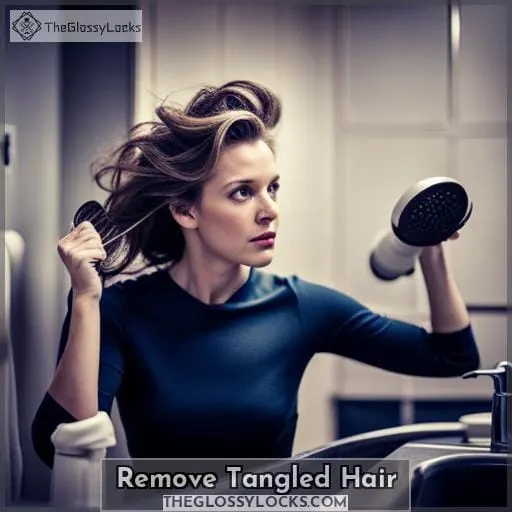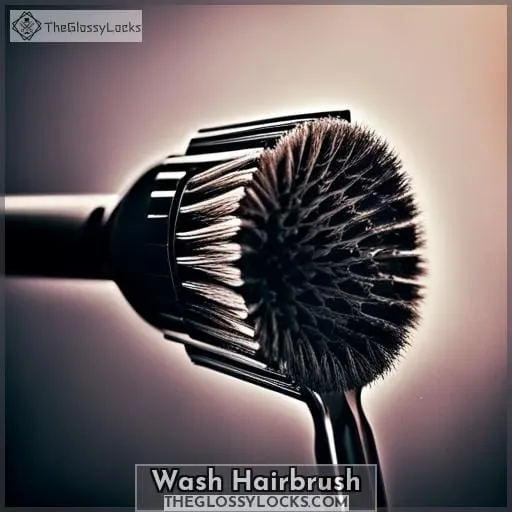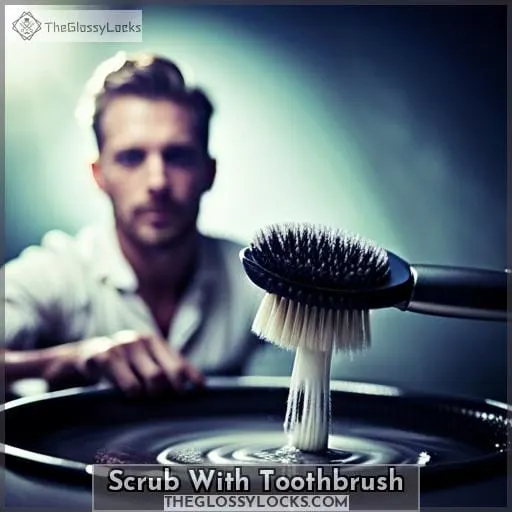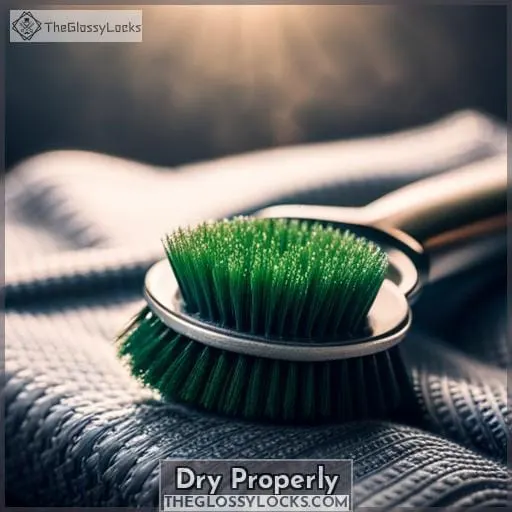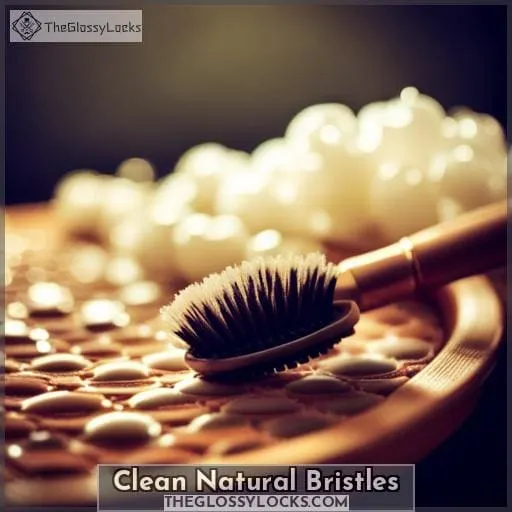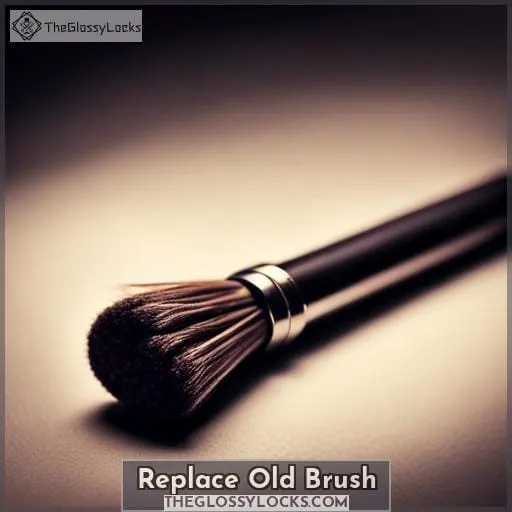This site is supported by our readers. We may earn a commission, at no cost to you, if you purchase through links.
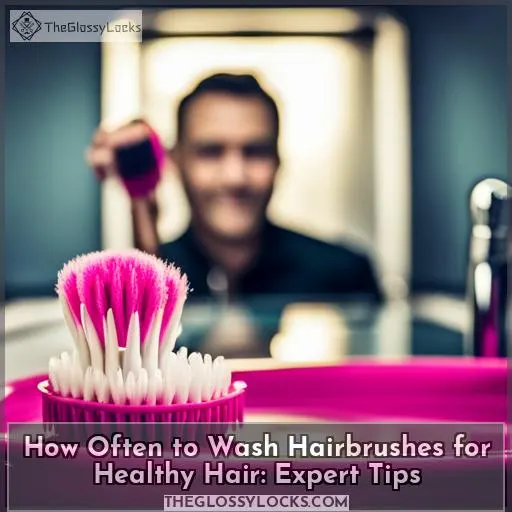
Give your locks their best chance by washing hairbrushes regularly—monthly for most, biweekly for long or frequently styled hair.
Table Of Contents
Key Takeaways
- Remove tangled hair before cleaning.
- Soak the brush in warm water and shampoo for 10 minutes.
- Scrub the bristles with a toothbrush.
- Rinse thoroughly under warm running water.
Remove Tangled Hair
How regularly should you remove tangled hair from your hairbrush for optimal hair health?
The answer is simple: as often as necessary.
Tangled hair can cause a host of issues, including breakage, split ends, and discomfort when brushing.
To prevent these problems and ensure healthy locks, it’s important to remove tangled strands from your brush regularly.
To begin the process, use a comb or a specialized tool like a hair pick to gently loosen the tangles. Start at the base of the bristles and work your way up towards the handle. If necessary, you can also use rubber bands or clips to hold sections of untangled hair in place while you focus on removing knots.
Once all visible tangles have been cleared away with proper tools such as combs or brushes designed specifically for this purpose (like rat tail combs), apply some baby oil or baking soda onto any remaining stubborn knots before carefully working them out using gentle motions – remember not to pull too hard! Finally rinse off residual oils by running lukewarm water over each side until clean; alternatively wipe down surfaces thoroughly after every use if desired results are achieved through regular maintenance practices such as washing hands beforehand then drying completely afterwards.
Wash Hairbrush
To clean your hairbrush,
- Fill a bowl with warm water and shampoo.
- Submerge the brush bristles in the solution and let soak for at least 10 minutes.
- Use a toothbrush to scrub the bristles and handle, rinsing thoroughly afterward.
Use Shampoo
After removing tangled hair, you’ll be wanting to wash the hairbrush by using some shampoo.
Fill a bowl with warm water and mix in a small amount of gentle shampoo. Then, immerse the brush bristles in the soapy solution to let it soak before scrubbing.
- Use baking soda if there’s a lot of buildup
- Use hot water if the brush is very dirty
- Use mild soap or shampoo so you don’t damage the bristles
- Use vinegar to help remove odors
Soaking the brush bristles in this sudsy bath will help loosen up residue before scrubbing.
Let Soak
When should you let your hairbrush soak?
You should let your hairbrush soak in a bowl or sink filled with warm water and a small amount of gentle shampoo for about 10 minutes.
For extra cleaning power, add one teaspoon of baking soda to help dissolve oils and product buildup.
Soak plastic-handled brushes completely but avoid soaking wooden handles.
Clean hairbrushes monthly and let them dry completely before use to prevent bacteria growth.
Rotate between a few brushes to lengthen time between deep cleanings.
Scrub With Toothbrush
To thoroughly clean your hairbrush, use a small toothbrush to scrub between the bristles. This step is crucial in removing any build-up or residue that may be trapped in the brush.
Here are four important tips to keep in mind when scrubbing with a toothbrush:
- Use gentle pressure: Apply enough pressure to effectively remove dirt and debris, but avoid being too rough as it can damage the bristles of your hairbrush.
- Avoid using harsh chemicals: Stick to mild soap or shampoo when cleaning your hairbrush. Harsh chemicals can deteriorate the bristles and affect their effectiveness.
- Rinse well: After scrubbing with a toothbrush, make sure you rinse off all soap or shampoo residues completely from both the brush and between its bristles.
- Avoid heat: Excessively hot water or heat should be avoided during both cleaning and drying processes as it can cause synthetic bristle misshaping or melting.
By following these guidelines for using a toothbrush, you can keep your hairbrush clean and free of build-up, ensuring that it continues to function properly.
Rinse Thoroughly
Once you’ve scr믭 your hairbrush clean, be sure to rinse it thoroughly in order to remove all traces of shampoo or soap.
Rinse the brush bristles under cool, running water until the water runs completely clear and you see no traces of soap suds.
Keep rinsing, working your fingers gently through the bristles, until all shampoo or soap residue has been removed.
The hairbrush bristles should feel squeaky clean before removing from the water.
Rinsing thoroughly ensures no product or dirt remains trapped within the bristles or handle, where it could transfer back to your hair.
Thorough rinsing prevents buildup over time, keeping your brush clean and maximizing its effectiveness at detangling and distributing oils.
So don’t stop rinsing until that water runs crystal clear – it’s a simple step that pays off in the long run with healthy, shiny hair.
Dry Properly
After rinsing your hairbrush thoroughly, it’s important to dry it properly to prevent any moisture buildup or damage.
Gently shake excess water from the bristles then hang your brush upside down, resting the handle on a towel rack or cup. Allow it to air dry completely before using again, avoiding direct sunlight or other heat sources which could warp synthetic bristles.
When drying, avoid subjecting hairbrushes to any harsh chemicals, abrasives or high temperatures which could damage bristles over time or strip protective coatings.
With proper techniques, you can keep hairbrushes fresh between deep cleanings every 4-6 weeks. This regular hairbrush cleaning schedule removes dead skin cells, oils and hair products before they can redeposit or create an unhealthy environment.
Clean Natural Bristles
To clean natural bristles on your hairbrush, it’s important to soak the bristles only and avoid submerging the handle or wooden parts.
Fill a shallow bowl with warm water mixed with gentle shampoo and let the brush soak for 10 minutes.
Then, use your hands to work the soapy mixture through the rows of bristles, making sure you reach down to the base.
Rinse thoroughly under warm running water and allow it to air-dry overnight with bristles facing down on a towel.
Soak Bristles Only
When you’re cleaning your natural-bristled brush, submerge only the bristles in a shallow bowl of warm, soapy water for 10 minutes—keeping the handle completely dry.
- Gently remove excess water from the bristles by shaking or patting them.
- Avoid heat styling tools to prevent damage to the natural bristles.
- Use a gentle shampoo specifically designed for hair brushes.
By following these steps, you can effectively clean your natural-bristled hairbrush without compromising its quality and longevity. Remember to always dry your brush with the bristles facing down and replace it every six months for optimal performance and healthy hair care practices.
Dry Overnight
To properly dry natural bristles on your hairbrush, you should:
- Lay the brush with the bristles facing down.
- Allow it to air-dry overnight.
Avoid using heat, as high temperatures can damage and dry out natural fibers.
Instead, place the wet brush on top of a clean towel or cloth, keeping the bristles pointed downwards.
Allowing it to slowly air dry helps retains the brush’s shape and suppleness.
For best results, replace your brush every 6 months or so to prevent product buildup.
And remember – avoid soaking wooden brush handles, use a bit of baking soda to dissolve residue, and change towels if they get too damp.
Doing these small things helps keep bristles clean and scalp healthy.
Sanitize Hairbrush
You should also lightly spray your hairbrush with a disinfecting spray like Lysol to kill any bacteria after cleaning it. This helps sanitize the brush and prevent the spread of germs or skin issues like dandruff.
To properly sanitize your brush:
- Spray liberally with a disinfectant after washing.
- Allow the disinfectant to sit for 2-3 minutes.
- Rinse briefly if needed, then allow to air dry.
Using a disinfectant spray ensures any lingering bacteria or buildup is eliminated. It’s an important final step after washing hair care tools thoroughly. Alternating disinfectants can help prevent resistant bacteria from accumulating over time.
With this quick sanitizing routine, you can keep your hairbrush clean and safe for healthy hair.
Replace Old Brush
When assessing if it’s time to replace your hairbrush, check for melted or frayed bristles.
If the bristles have lost their shape or have separated and frayed at the ends, it’s a clear sign your brush is past its prime.
Investing in a new brush with intact bristles can make detangling easier and prevent damage to the hair and scalp.
Melted Bristles
How often should you replace your hairbrush if the bristles are melted and separated?
Every 3-6 months is ideal. Melted, fraying bristles mean it’s time to toss your faithful companion. They can no longer effectively cleanse follicles or scalp without causing damage. Clean styling calls for a sturdy brush. inspect yours monthly. If bristles appear melted, making hair look unkempt, replace it.
A quality brush costs $10-$30 but promotes shine and health. Invest in yourself for best results.
| Damaged Bristle Signs | Replace Every |
|---|---|
| Melted | 3-6 months |
| Frayed | 3-6 months |
| Fall Out Easily | 6-12 months |
| Look Worn | 6-12 months |
| Miss Bristles | 6-12 months |
Frayed Bristles
By the time you’re spotting frayed bristles all over your hairbrush, it’s high time to replace the old brush with a shiny new one.
Frayed bristles aren’t only unsightly, but they can also cause damage to your hair.
When the bristles become frayed, they lose their ability to effectively detangle and distribute natural oils throughout your strands.
To prevent this from happening in the future, make sure to use a brush with sturdy bristles that can withstand regular use without becoming damaged or frayed.
Frequently Asked Questions (FAQs)
Can I use dish soap to clean my hairbrush?
No. Dish soap is too harsh for hairbrush bristles.
Instead, use a gentle shampoo or soap and lukewarm water to clean the brush. This protects bristles while lifting away oils and product buildup.
Let air dry completely before using again.
How often should I replace my hairbrush?
Replace your hairbrush every 6 months.
Regular replacement prevents buildup that leads to damaged, unclean hair.
Is it necessary to sanitize my hairbrush?
Yes, it’s wise to sanitize your hairbrush regularly.
This prevents buildup of oils, dead skin, and product residue which can transfer to hair and scalp, potentially causing irritation or inflammation.
Use rubbing alcohol or disinfectant spray weekly.
Allow to fully dry before use for best results.
Can I use rubbing alcohol to clean my hairbrush?
Yes, you can use rubbing alcohol to clean your hairbrush.
It helps kill bacteria and remove residue.
After cleaning, let the brush air dry completely before using it again for optimal hygiene and hair health.
How do I remove stubborn residue from my hairbrush?
To remove stubborn residue from your hairbrush, start by removing any hair.
Then, soak the brush in warm soapy water and use a toothbrush to scrub away the residue.
Rinse thoroughly and let it dry completely before using again.
Conclusion
Ultimately, regularly washing your hairbrush keeps hair healthy by removing buildup.
Schedule monthly, biweekly, or more frequent brush cleanings depending on hair type and styling routine.
Use shampoo, scrub with a toothbrush, rinse thoroughly, and let air dry.
Sanitize occasionally too.
Remember—replace any brush with frayed or melted bristles.
Caring for your hairbrush properly allows it to continue caring for your hair.

